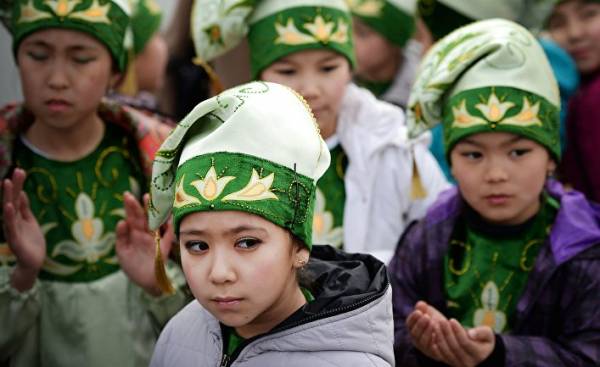
In 2035, children born in Muslim families, will exceed the number of children born in Christian families; for people with no religious beliefs then they will face a fall in the birth rate.
In recent years, mother’s Christian faith gave birth to more children than mothers of any other religion, and it reflects the status of Christianity as the world’s largest religious group. However, it is unlikely that this situation will last long — less than 20 years, the number of children born in Muslim families is expected to slightly surpass the number of births in Christian families. To such conclusions came in a new report, the experts of the Pew Research center (Pew Research Center).
According to experts, the Pew Research center, Muslims in the coming decades will be the fastest growing main religious group in the world, and signs of rapid growth are already visible. In the period between 2010 and 2015 the number of births of Muslims, according to estimates, accounted for 31% of all births in the world, and it was much greater than the proportion of Muslims of all ages in 2015 (24%). The Christian population in the world also continues to grow, but this growth is more modest. In recent years, 33% of the world’s children were born in Christian families, slightly more than the proportion of Christians in the world population in 2015 (31%).
While a relatively young population such as regions located South of Sahara Africa, according to current projections, will increase in the coming decades, the same cannot be said about the Christian population in different parts of the world. And, indeed, in recent years, Christians had a disproportionate share of global mortality (37%) — this is largely due to the relative older age of Christians in some parts of the globe. This is especially true in Europe, where the number of deaths, it is estimated that already exceeds the number of births among Christians. In Germany, for example, in the period between 2010 and 2015 was fixed at 1.4 million more deaths than births, and this trend is expected to persist in many parts of Europe over the next decades.
As for the global scale, the younger generation and very high fertility among Muslims suggests that in the period between 2030 and 2035 years will be born a little more Muslim children (225 million) than Christian (224 million), although the total number of Christians will still be more. In the period 2055 year 2060, the gap in fertility between these groups is expected to reach 6 million (232 million births among the Muslims against 226 million births among Christians).
Unlike similar explosive growth in the birth rate among Muslims, people who don’t identificeret themselves with any religion, are the completely different trends. While people with no religious affiliation account for 16% of the world’s population, only about 10% of newborns in the world in the period from 2010 to 2015 were born to women not affiliated with any religion. This is a small number of births among women with no religious affiliation helps explain why the proportion of non-religious people (including those who call themselves atheists or agnostics, as well as those who have no particular religious beliefs) in the future will be reduced.
In the period from 2055 to 2060 year only 9% of all children are born to women not affiliated with any religion, whereas seven out of ten children will be born or Muslims (36%) or Christian (35%).
This is one of the key findings in a new study demographic data conducted by the Pew Research center. This analysis is based on the same database that contains the results of the 2500 questionnaires, observation and registration of the population used for published in 2015 report, “the Future of the world’s religions: prospects for population growth in the period from 2010 to 2050” (The Future of World Religions: Population Growth Projections, 2010-2050). Both reports have a common demographic forecast model, however, data regarding births and deaths contained in this analysis have not been published before.
In addition, the new report provides updated estimates of global population by 2015, against Christians, Muslims, men, not professing any religion, as well as representatives of other religious groups. In addition, the forecast of population growth in this report covers the period up to 2060, that is ten years more than in the previous report.
In developing their forecasts, the authors of the report came from the fact that all the born children retain the religion of their mothers. When formulating projections, an attempt was made to consider possibility of change of religion (in all directions), however, the patterns of adoption of the religions are complex and diverse. In some countries, including the United States, it is quite common to this practice, when adults emerge from adopted in childhood religion and convert to another faith (or not take any faith at all). For example, many people raised in the United States as Christians, as adults lose touch with religion and Vice versa — many people raised outside of religion, later joined to any religion. However, in some other countries changes in religious identity are rare or prohibited by law.
Currently, the most reliable data indicate that globally in the next few decades, the impact of a change of religion — in the absence of any other factors — will slightly affect the increase in the number of Muslims will cause a significant increase in people without religious belonging, and also will lead to a significant reduction in the number of Christians. Globally, however, the effect of change of religion overlap with the effects of differences in fertility and mortality. As a result, according to forecasts, the share of people without religious belief in the world as a whole will decline, despite the expected increase in their number, and it will happen at the expense of leaving the Church Christians and followers of other religious groups in Europe, North America and some other parts of the world. A number of Christians, according to forecasts, will increase, although not as rapidly as the number of Muslims.
Projections of global population in the period from 2015 to 2060
Christians were the largest religious group in the world in 2015, and they accounted for about a third (31%) of the total number of people in the world (7.3 billion). Muslims occupied the second place (1.8 billion, or 24%) in the world by population, followed by people “without religion” (16%), Hindus (15%) and Buddhists (7%). Representatives of the popular religions (folk religions), Jews and members of other religious groups constitute less than a significant portion of the world population.
In the period from 2015 to 2060 the population is expected to increase by 32% and will reach 9.6 billion people. In the same period, the number of Muslims, the main religious group with the youngest population and highest birth rate will increase, according to forecasts, 70%. The number of Christians is expected to increase by 34%, and this growth will be slightly higher than the global population overall, but much lower than among Muslims.
As a result, according to forecasts by the Research center Pew, in 2060 the number of Muslims (3.0 billion, or 31% of the world population) approaches the number of Christians (3.1 billion or 32%).
With the exception of Muslims and Christians, all religions of the world, according to forecasts, in 2060 will constitute a smaller percentage of the global population than it was in 2015. While Hindus, Jews and supporters of people’s religions in the coming decade, expected to grow in absolute terms, none of these religions will not be able to match pace with global population growth.
Worldwide, the number of Hindus are expected to grow by 27% — from 1.1 billion to 1.4 billion, and they will be slightly behind the growth rate of overall population growth. The number of Jews is the smallest group, about which projections were made, is expected to increase by 15%, from 14.3 million in 2015 to 16.4 million globally in 2060. And representatives of various folk religions including African traditional religions, Chinese folk religions, religions of the indigenous peoples of America and the religion of the Australian aborigines — will grow, according to forecasts, by 5%, from 418 million to 441 million.
Meanwhile, the number of Buddhists are expected to decline in absolute terms; it will decrease by 7% from 500 million in 2015 to 462 million in 2060. Low birth rate and aging population in countries such as China, Thailand and Japan are the main demographic reasons for the expected reduction in the near future the number of people practicing Buddhism.
The number of the representatives of all other religions is an umbrella category includes Baha’is (Baha’is), Jains (Jains), Sikhs, and a large number of small religions according to the forecasts is slightly reduced from approximately 59.7 million in 2015 to 59.4 million in 2060.
The number of people without religious beliefs are expected to decrease as a percentage compared to the global population, although in absolute terms it increased slightly. In 2015, the world was a little less than 1.2 billion atheists, agnostics and people who did not associate themselves with any religion. In 2060 the number of people without religious beliefs, according to forecasts, will reach 1.2 billion. However, the proportion of people without religion (religious “nones”) in the world, expected to decline from 15% of the total population in 2015 to 13% in 2060. Although the share of people without religious affiliation is likely to continue to increase in much of Europe and North America, the proportion of people without religion will decline in Asia, where 75% of people who do not profess any religion.
Such geographical differences play an important role in the numerical patterns of religious development. One of the important determinants of growth is the fact exactly where every single group is concentrated geographically. For example, people without religious beliefs is concentrated in places with an aging population and low birth rate as China, Japan, Europe and North America. Conversely, religions with a large number of followers concentrated in the developing countries where fertility and infant mortality high, will quickly increase their performance. For example, a significant part of the global growth of Islam and Christianity, according to projections, will happen in South of Sahara part of Africa.
Changing areas of concentration of religious groups
The regional distribution of religious groups, according to forecasts, will also change in the coming decades. For example, the proportion of Christians living in South of Sahara part of Africa are projected to increase significantly in the period between 2015 and 2060 year on year from 26% to 42%, and it will happen as a result of high fertility rates in the region. Meanwhile, the change of religion and low birth rates will reduce the global share of Christian population in Europe and North America.
On the part of the African continent South of the Sahara, is expected to increase the share of the Muslim population. By 2060, 27 percent of the global Muslim population is expected to live in this region, there will be an increase of 15%. Conversely, the proportion of Muslim population residing in the Asia-Pacific region is projected to decline during this period from 61% to 50%. The share of the Muslim population in the middle East and North Africa are expected to remain at 20%.
As of 2015, three out of four people not affiliated with any religion, live in the Asia-Pacific region. However, their share in 2060 will be reduced to 66% as a result of the low birth rate and aging population. At the same time, an increasing number are not associated with any religion people will live outside the Asia-Pacific region, especially in Europe and North America. By 2060, 9% of the global population without religious affiliation, according to forecasts, will live alone in the United States.
A large majority of Hindus and Buddhists (98-99%) will continue to live in the Asia-Pacific region in the next few decades. The majority of fans of folk religions also remain in Asia and the Pacific region (79% in 2060), although, as expected, their share in sub-Saharan Africa will increase (7% in 2015 and 16% in 2060). Approximately the same proportion of Jews in the world, according to 2015, I live in Israel (42%) and in the United States (40%). However, by 2060, more than half of Jews (53%) are expected to live in Israel, whereas in America, their share is projected to be less (32%).
Age and fertility are important factors in the growth of religious groups
Current age structure of the population in all religious groups is an important determinant of population growth. Representatives of some religious groups are primarily young people, and their main reproductive age yet to come, while members of other religious groups, mostly left far behind your the reproductive period. Median age among Muslims (24 years) and Hindus (27 years old) less than the average age for the world population as a whole (30 years), whereas the median age of Christians (30 years) corresponds to the average of the world data. Representatives of other religious groups older than the world average, and this partly explains their expected partial lag behind the global rate of population growth.
Moreover, Muslims have the highest fertility rates among all religious groups — an average of 2.9 children per woman, and it is much more than recovery (2,1), i.e. the minimum required to maintain a stable population level. Christians hold on this indicator (2,6) second place in the world. Hindus and Jews (2,3) are in this respect below the world average, which is 2.4 children per woman. All other groups have a too low birth rate to maintain the numerical level of its population.
In addition to the level of fertility and the age structure of the population should be say that and change religions, apparently, will play a role in changing the quantitative composition of religious groups.
In its forecast the Pew Research center attempts to account for patterns of religious developments in 70 countries, which have conducted studies provide information about the people who, according to them, no longer belong to those religious groups in which they were raised. In this predictive model possible shifts in all directions, and they are partly able to compensate for each other. In the United States, for example, as a result of the studies, it was found that very often people raised in the Christian tradition, moving away from religion, whereas people brought up outside of any religion, later becoming Christians. Such patterns are expected to persist as they grow older future generations.
In the period between 2015 and 2020 Christians, according to forecasts, will experience the most significant losses in the process of changing religions. Globally, about 5 million people are expected to become Christians in this five-year period, while projected 13 million to leave the bosom of the Christian Church, and most of these ex-Christians will join the ranks of people without religious affiliation. As a result of these changes, the number of people without religious affiliation increased by 12 million and will be reduced by 4.6 million as a result of shifts, that is, the net gains they will make in the period from 2015 to 2020 7.6 million. Similar net changes result in shifts will be less significant in other religious groups.
Fertility and mortality contribute your changes
As the largest religious group, Christians had the highest rates of fertility and mortality among the other groups in the period between 2010 and 2015. During this five-year period, according to existing estimates, the Christian mother gave birth to 223 million children, and 107 million Christians died, and this means that the natural increase of the Christian population in this period — that is, births minus deaths — amounted to 116 million people.
Muslims ranked second in the number of births in the period from 2010 to 2015, and a Muslim mother gave birth to 213 million children. However, the Muslims had the largest natural increase among all other religious groups — more than 152 million — and it happened in due to the relatively small number of deaths (61 million people). Such a large natural increase is a result of both the high birth rate among Muslims and a concentration of the Muslim population in the younger age groups where the mortality rate is lower.
In comparison with the total number of people with no religious affiliation (16% of the world population) has a relatively smaller number of births from mothers with no religious affiliation (10% of births of the total number in the period from 2010 to 2015). People who do not profess any religion, are the third group in number, however, due to low fertility, they go after Hindus and occupy the fourth place in the number of children born. In the period between 2010 and 2015, according to estimates, mothers with no religious affiliation gave birth to 68 million children, while the Hindu mothers gave birth to 109 million children. The Hindus, moreover, was marked with a significantly greater natural increase than in the group of people with no religious affiliation (67 million versus 26 million).
The number of births exceeded the number of deaths and among other religious groups in the period from 2010 to 2015, including Buddhists, Jews and adherents of folk religions.
After 2015, according to forecasts, Christian and Muslim mothers will have more children, and it will continue until 2060. However, the birth rate among Muslims is likely to increase more rapidly, and therefore, in 2035, the number of children born to Muslim women, will slightly exceed the number of children born to Christian mothers. In the period between 2055 and 2060 year year the gap in fertility between these two groups is expected to approach the 6 million (232 million births for Muslims against 226 million births Christians).
In contrast, the total number of births, projected to decline continuously in the period from 2015 to 2060 in all other main religious groups. The decline of fertility will be especially significant for Hindus — 33 million fewer births in the period from 2055 to 2060 year than in the period from 2010 to 2015, and it will happen mainly due to declining birth rates in India, where in 2015 he lived for 94% of the Hindu population of our planet.
The number of deaths is expected to increase in all religious groups in the period from 2015 to 2060, while the world population will continue to grow — and to grow old.
The patterns of births and deaths at the regional level and at the level of individual countries
As for the religious groups in most countries, at the present time you can talk about a positive natural increase (more births than deaths) or a slight increase as a result of births and deaths. However, many European countries are experiencing natural decrease (more deaths than births) population among certain religious groups, especially among Christians.
Throughout Eastern Europe and parts of Western Europe the number of deaths exceeded the number of births among Christians in the period from 2010 to 2015, and so it was in 24 of the 42 countries. The number of deaths exceeded the number of births, at least 10 thousand among people with no religious affiliation in Austria, Ukraine and Russia. However, people with no religion in most European countries had either a positive natural growth (in 19 countries), or minor numerical change in the period from 2010 to 2015 (in 20 countries). This is due to the relatively young age of people with no religious affiliation compared to Christian population of Europe.
As for the Muslims, there was not a single European country where the number of deaths among them would surpass the number of births. In most regions the number of children born to Muslim women exceeded the number of deaths among Muslims in the period from 2010 to 2015 (in 21 countries). In Germany, the United Kingdom, Italy, Russia and France was, at least on 250 thousand births more than deaths in each of these countries during this period. Moreover, migration also contributes to the growth of the Muslim population in Europe.
Neither Christians nor Muslims, nor people without religion who live outside of Europe, had more deaths than births in the period from 2010 to 2015. Other groups also had positive natural increase, or a minor change; but there were some exceptions: in Japan, the Buddhists, the Hindus in South Africa and representatives of national religions in South Korea, and Tanzania had more deaths than births in the period from 2010 to 2015.
In addition, there are important regional differences in terms of birth and death in some religious groups. Among Christians, for example, the inhabitants of Africa South of the Sahara had a greater natural increase in the period from 2010 to 2015 — 64 million more births than deaths. At the same time was marked by lower growth among Christians in Latin America, the Caribbean, Asia, and the Asia-Pacific region, and North America.
However, in Europe the number of deaths Christians already exceeds the number of births, and a similar deficit is projected to increase until 2060. And in North America the number of deaths of the Christians will begin to surpass the number of births by about 2050.
These trends indicate that a significant portion of the increase among the Christians, most likely, will come from the global South, especially in sub-Saharan Africa is the only region where the natural growth of the Christian population is expected to increase further in the coming decades (This means not only that there will be more births than deaths among Christians in Africa South of the Sahara, but that the number of births will exceed the number of deaths in the next five-year periods). In Latin America and in the Asia-Pacific region the number of births among Christians will continue to exceed the number of deaths until 2060, however, the natural increase in the period 2055 year 2060 will be much less than now, since in these regions there has been a significant decline in fertility.
The global Muslim population is projected to experience an important geographical shift in the direction located to the South of the Sahara Africa. Currently, more Muslims live in the Asia-Pacific region than in any other region of the world, and therefore this region had the largest natural increase among Muslims in the period from 2010 to 2015.
However, Muslims in sub-Saharan Africa also had significantly more births than deaths in this period, and the natural increase among the Muslim population in countries South of the Sahara, is expected to be even more in the next five — year periods, due to the high birth rate. By around 2040, natural increase of the Muslim population South of the Sahara, is expected to exceed the natural increase in Asia.
Muslims in Asia, the middle East and North Africa will have slower growth in the coming decades, as the birth rate of the Muslims in these regions will be reduced. However, they retain a higher level of births than deaths, and this will continue until 2060, but growth overall will slow.
Muslims in Europe and in North America, as expected, also will have more births than deaths until 2060.
Currently, there is more births than deaths among non-believers in all regions, and leading among them is the Asia-Pacific region, which is home to most of the global population without religious affiliation.
However, this situation in the coming years will change. The number of deaths from non-believers in Asia will begin to exceed the number of births from not having a religious affiliation of mothers by 2030, and this change will be caused by low fertility and the relatively aged population of unbelievers in China. By 2035 the number of deaths from non-believers, expected to exceed the number of births in Europe.







